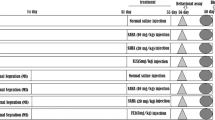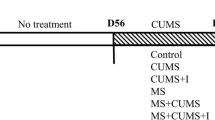Abstract
This study is to determine the role and mechanism of hippocampal acetylation in prenatal stress (PS) induced depression-like behavior of male offspring rats. PS-induced depression rat model was established. Sucrose preference and forced swim test were used to observe the behavior changes of male offspring rats. Hippocampal acetylation was induced by Trichostatin A injection. Quantitative real-time PCR and Western blot were used to determine the changes of AMPARs in acetylated hippocampus. The behavioral tests proved that AMPA was involved in the PS-induced depression-like behavior in offspring rats. Hippocampal acetylation significantly increased the preference to sucrose of PS-induced offspring rats and reduced the immobile time in forced swimming test, suggesting that acetylation could improve PS-induced depression-like behaviors. In addition, PS inhibited the expression levels of GluA1-3 subunits of AMPARs in the offspring hippocampus, while Hippocampal acetylation could reverse this effect by increasing GluA1-3 expression. PS-induced reduction of GluA1-3 subunits of AMPARs may be an important potential mechanism of offspring depression. Hippocampal acetylation may improve PS-induced offspring depression-like behavior through the enhanced expression of AMPARs (GluA1-3 subunits).




Similar content being viewed by others
References
Beebe B, Badalamenti A, Jaffe J et al (2008) Distressed mothers and their infants use a less efficient timing mechanism in creating expectancies of each other’s looking patterns. J Psycholinguist Res 37(5):293–307
Champagne FA (2010) Epigenetic influence of social experiences across the lifespan. Dev Psychobiol 52(4):299–311
Talge NM, Neal C, Glover V (2007) Antenatal maternal stress and long-term effects on child neurodevelopment: how and why? J Child Psychol Psychiatry 48(3–4):245–261
Zeng J, Zhu ZL, Li H et al (2015) Maternal stress in gestation: birth outcomes and stress-related hormone response of the neonates. Pediatr Neonatol 56(6):376–381
Lixia Guan Ning, Jia Xiaoyan, Zha et al (2013) The involvement of ERK/CREB/Bcl-2 in depression-like behavior in prenatally stressed offspring rats. Brain Res Bull 99:1–8
Jia N, Yang K, Sun Q et al (2010) Prenatal stress causes dendritic atrophy of pyramidal neurons in hippocampal CA3 region by glutamate in offspring rats. Dev Neurobiol 70(2):114–125
Niciu MJ, Ionescu DF, Richards EM et al (2014) Glutamate and its receptors in the pathophysiology and treatment of major depressive disorder. J Neural Transm 121:907–924
Aleksandrova LR, Phillips AG, Wang YT (2017) Antidepressant effects of ketamine and the roles of AMPA glutamate receptors and other mechanisms beyond NMDA receptor antagonism. J Psychiatry Neurosci 42(2):160–175
Beneyto M, Meador-Woodruff JH (2004) Expression of transcripts encoding AMPA receptor subunits and associated postsynaptic proteins in the macaque brain. J Comp Neurol 468:530–554
Wiedholz LM, Owens WA, Horton RE et al (2008) Mice lacking the AMPA GluR1 receptor exhibit striatal hyperdopaminergia and ‘schizophrenia-related’ behaviors. Mol Psychiatry 13:631–640
Li X, Tizzano JP, Griffey K, Clay M et al (2001) Antidepressant-like actions of an AMPA receptor potentiator (LY392098). Neuropharmacology 40:1028–1033
Li X, Witkin JM, Need AB et al (2003) Enhancement of antidepressant potency by a potentiator of AMPA receptors. Cell Mol Neurobiol 23:419–430
Kllarackal AJ, Kvarta MD, Cammarata E et al (2013) Chronic stress induces a selective decrease in AMPA receptor-mediated synaptic excitation at hippocampal temporoammonic-CA1 synapses. J Neurosci 33:15669–15674
Machado-Vieira R, Henter ID, Zarate CA Jr (2015) New targets for rapid antidepressant action. Prog Neurobiol 152:21–37
Ferland Chantelle L., Erin P, Harris et al (2014) Facilitation of the HPA axis to a novel acute stress following chronic stress exposure modulates histone acetylation and the ERK/MAPK pathway in the dentate gyrus of male rats. Endocrinology 155(8):2942–2952
Sarkar A, Chachra P, Kennedy P et al (2014) Hippocampal Hdac4 contributes to postnatal fluoxetine-evoked depression-like behavior. Neuropsychopharmacology 39(9):2221–2232
Erburu M, Muñoz-Cobo I, Dominguez-Andrés et al (2015) Chronic stress and antidepressant induced changes in Hdac5 and Sirt2 affect synaptic plasticity. Eur Neuropsychopharmacol 25(11):2036–2048
Sun H, Jia N, Guan L et al (2013) Involvement of NR1, NR2A different expression in brain regions in anxiety-like behavior of prenatally stressed offspring. Behav Brain Res 15(257):1–7
Koehl M, Darnaudéry M, Dulluc J, Van Reeth O, Moal ML, Maccari S (1999) Prenatal stress alters circadian activity of hypothalamo-pituitary-adrenal axis and hippocampal corticosteroid receptors in adult rats of both gender. J Neurobiol 40:302–315
Paxinos G, Watson C (1986) The rat brain in stereotaxic coordinates, 2nd edn. Academic Press, New York
Rodríguez MJ, Robledo P, Andrade C et al (2005) In vivo co-ordinated interactions between inhibitory systems to control glutamate-mediated hippocampal excitability. J Neurochem 95(3):651–661
Liu H, Wen LM, Qiao H et al (2013) Modulation of hippocampal glutamate and NMDA/AMPA receptor by homocysteine in chronic unpredictable mild stress-induced rat depression. Sheng Li Xue Bao 65(1):61–71
Inokoshi J, Katagiri M, Arima S et al (1999) Neuronal differentiation of neuro 2a cells by inhibitors of cell cycle progression, trichostatin A and butyrolactone I. Biochem Biophys Res Commun 256(2):372–376
Wang H, Florian D, Yan L et al (2013) Histone deacetylase inhibitors facilitate partner preference formation in female prairie voles. Nat Neurosci 16(7):919–924
Guan L, Jia N, Zhao X, Zhang X et al (2013) The involvement of ERK/CREB/Bcl-2 in depression-like behavior in prenatally stressed offspring rats. Brain Res Bull 99:1–8
Jia N, Li Q, Sun H et al (2015) Alterations of group I mGluRs and BDNF associated with behavioral abnormity in prenatally stressed offspring rats. Neurochem Res 40:1074–1082
Sun H, Guan L, Zhu Z et al (2013) Reduced levels of NR1 and NR2A with depression-like behavior in different brain regions in prenatally stressed juvenile offspring. PLoS ONE 8(11):e81775
Chourbaji S, Vogt MA, Fumagalli F et al (2008) AMPA receptor subunit 1 (GluR-A) knockout mice model the glutamate hypothesis of depression. FASEB J 22(9):3129–3134
Heim C, Binder EB (2012) Current research trends in early life stress and depression: review of human studies on sensitive periods, gene-environment interactions, and epigenetics. Exp Neurol 233:102–111
Booij SH, Bos EH, De Jonge P et al (2014) Markers of stress and inflam-mation as potential mediators of the relationship between exercise and depressive symptoms: findings from the trails study. Psychophysiology 52(3):352–358
Davis DA, Bortolato M, Godar SC et al (2013) Prenatal exposure to urban air nanoparticles in mice causes altered neuronal differentiation and depression-like responses. PLoS ONE 8:e64128
Levenson JM, Sweatt JD (2005) Epigenetic mechanisms in memory formation. Nat Rev Neurosci 6:108–118
Maddox SA, Schafe GE, Ressler KJ (2013) Exploring epigenetic regulation of fear memory and biomarkers associated with post-traumatic stress disorder. Front Psychiatry 4:62
Miller CA, Sweatt JD (2007) Covalent modification of DNA regulates memory formation. Neuron 53:857–869
Nasca C, Zelli D, Bigio B et al (2015) Stress dynamically regulates behavior and glutamatergic gene expression in hippocampus by opening a window of epigenetic plasticity. Proc Natl Acad Sci USA 112(48):14960–14965
An XL, Tai FD (2013) AVP and Glu systems interact to regulate levels of anxiety in BALB/cJ mice. Zool Res 35(4):319–325
Duric V, Banasr M, Stockmeier CA et al (2013) Altered expression of synapse and glutamate related genes in post-mortem hippocampus of depressed subjects. Int J Neuropsychopharmacol 16(1):69–82
Yuen EY, Wei J, Liu W et al (2012) Repeated stress causes cognitive impairment by suppressing glutamate receptor expression and function in prefrontal cortex. Neuron 73(5):962–977
Penn AC, Balik A, Wozny C et al (2012) Activity-mediated AMPA receptor remodeling, driven by alternative splicing in the ligand-binding domain. Neuron 76(3):503–510
Viltart O, Vanbesien-Mailliot CC (2007) Impact of prenatal stress on neuroendocrine programming. Sci World J 7:1493–1537
Cottrell EC, Seckl JR (2009) Prenatal stress, glucocorticoids and the programming of adult disease. Front Behav Neurosci 3:19
Welberg LAM, Seckl JR, Holmes MC (2001) Prenatal glucocorticoid programming of brain corticosteroid receptors and corticotrophin-releasing hormone: possible implications for behaviour. Neuroscience 104(1):71–79
Mueller BR, Bale TL (2008) Sex-specific programming of offspring emotionality after stress early in pregnancy. J Neurosci 28(36):9055–9065
Acknowledgements
This work was supported by National Natural Science Foundation of China (No. 81271497) and Medical and Health Technology Development Project of Shandong Province (No. 2015WS0452).
Author information
Authors and Affiliations
Corresponding author
Ethics declarations
Conflict of interest
All authors declare no financial and non-financial competing interests.
Rights and permissions
About this article
Cite this article
Lu, Y., Zhang, J., Zhang, L. et al. Hippocampal Acetylation may Improve Prenatal-Stress-Induced Depression-Like Behavior of Male Offspring Rats Through Regulating AMPARs Expression. Neurochem Res 42, 3456–3464 (2017). https://doi.org/10.1007/s11064-017-2393-7
Received:
Revised:
Accepted:
Published:
Issue Date:
DOI: https://doi.org/10.1007/s11064-017-2393-7




